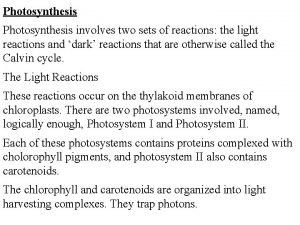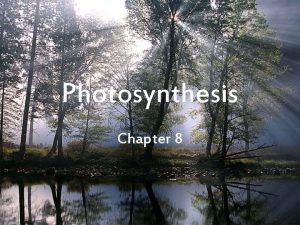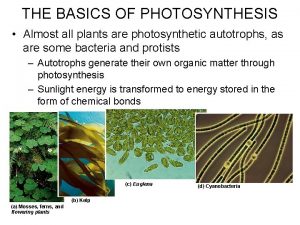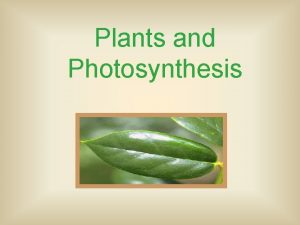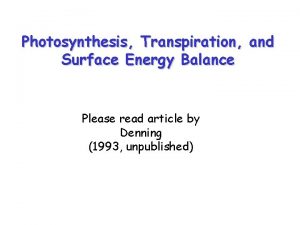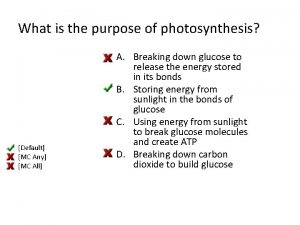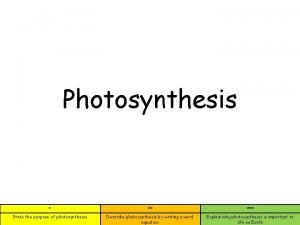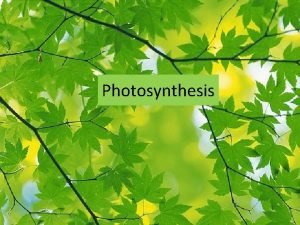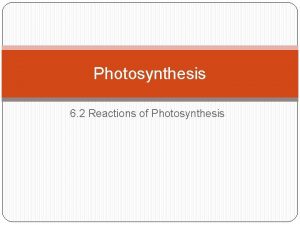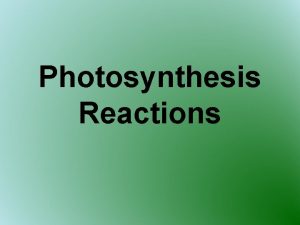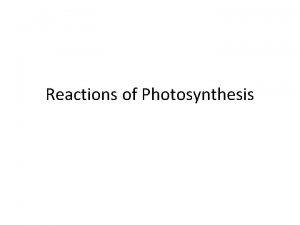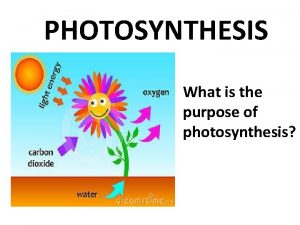Photosynthesis 6 2 Reactions of Photosynthesis Photosynthesis Purpose














- Slides: 14

Photosynthesis 6. 2 Reactions of Photosynthesis

Photosynthesis �Purpose: to use photons from sunlight to create glucose - solar energy converted to usable chemical energy �Occurs in the thylakoid membranes within chloroplasts �Requires 6 molecules of CO 2 and 6 molecules of H 2 O �During photosynthesis, many complex chemical reactions form intermediates and final energy-rich molecules - ATP: principal energy-supply molecule for living cells (immediate) - NADPH: electron donor in energy transfers

ATP and NADPH �Used by ALL living things as an immediate source of energy for cellular functions �Formed by addition of phosphate group (Pi) to a molecule of lower energy ADP. �NADP+ accepts one hydrogen atom and 2 electrons to form NADPH. - these electrons can then be donated to other molecules and NADPH becomes NADP+ again.

Reactions �Stage 1: capturing solar energy and transferring it to electrons �Stage 2: using captured solar energy to make ATP and to transfer high-energy electrons to NADP+; creates NADPH (electron carrier) �Stage 3: energy stored in ATP and electrons carried by NADPH used to form glucose from CO 2 �Stage 1 & 2: light dependent reactions requiring chlorophyll �Stage 3: light independent Calvin Cycle forming glucose (due to carbon fixation)


Capturing Solar Energy (Stage 1) �Photosystems: clusters of chlorophyll and pigment molecules - found on thylakoid membranes - 2 distinct but interconnected photosystems (I & II) �Electrons in chlorophyll capture and absorb photons - electron now has high amount of energy (excited state) �High-energy electrons move along electron transport chain - NEED TO BE REPLACED! �Photolysis: solar energy used to split H 2 O into H+ and O 2 gas - occurs in thylakoid lumen - 2 H 2 O molecules consumed for every 4 electrons

Electron Transfer & ATP Synthesis (Stage 2) �Electron Transport Chain: excited electrons are passed along the chain, slowly releasing energy in each step - some of this energy is captured to make ATP - electrons eventually rejoin H+ to form new

Electron Transfer & ATP Synthesis (Stage 2) � Photolysis: splits water, electrons move into Photosystem II � Electrons then passed along ETC toward the inside of the thylakoid membrane. - releases energy - draws H+ ions across membrane toward lumen - concentration of H+ ions in lumen increases creating buildup of positive charge � Electrons enter Photosystem I - replace electrons energized by light � Energized electrons move through chemical complexes to NADP+ - accepts 2 high- energy electrons and an H+ ion; becomes NADPH - NADPH used in light-independent reaction (Calvin


Chemiosmosis �H+ ions pulled across membrane into lumen - creates concentration gradient; H+ cannot escape unless through ATP synthase complexes - movement through releases energy �Combines ADP with Pi. . creates. . ATP! �Recall: energy stored in H+ ion gradient derived from energy of electrons energized in Photosystem II

Review Stage 2 Light-dependent reactions: �Consume water �Form ATP, NADPH, oxygen �ATP and NADPH used in carbon fixation - light-independent Calvin Cycle (Stage 3)

Calvin Cycle & Carbon Fixation (Stage 3) �Final stage of photosynthesis - results in formation of high-energy organic molecules from CO 2 (carbon fixation) �Calvin Cycle: - occurs in the STROMA of chloroplasts - CO 2 must be readily available -utilizes both ATP and high-energy electrons on NADPH from light-dependent reactions - makes G 3 P (or PGAL), a sugar used to create glucose

Calvin Cycle & Carbon Fixation (Stage 3) Steps of Calvin Cycle: �must cycle 6 times for 1 glucose to be produced �Atmospheric CO 2 diffuses into chloroplast - carbon joins 5 -carbon sugar Ru. BP (ribulose biphosphate) - forms unstable 6 -carbon sugar �Splits into TWO 3 -carbon sugars PGA (phosphoglyceric acid) �PGA’s use energy of ATP to strip H from NADPH - makes a stable 3 -carbon organic compound (G 3 P or PGAL) and water �PGAL (G 3 P): some goes on to make glucose, rest converted to Ru. BP to continue cycle

PGAL (G 3 P) �The PGAL that goes on to make glucose must be united with another molecule of PGAL in order for glucose to be formed. �PGAL therefore has 3 important functions: - used for energy to fuel the light independent reaction - some can be converted to glucose for energy storage - a portion is used to replenish Ru. BP and drive the cycle
 Section 2 reinforcement classifying chemical reactions
Section 2 reinforcement classifying chemical reactions Unit 5 chemical reactions answers
Unit 5 chemical reactions answers Redox reaction
Redox reaction Section 2 reinforcement classifying chemical reactions
Section 2 reinforcement classifying chemical reactions Chemical reactions section 3 reactions in aqueous solutions
Chemical reactions section 3 reactions in aqueous solutions What are the two sets of reactions in photosynthesis
What are the two sets of reactions in photosynthesis Section 8-2 photosynthesis
Section 8-2 photosynthesis Inputs of light reactions in photosynthesis
Inputs of light reactions in photosynthesis Solar grabber
Solar grabber Autotrophs self-feeder
Autotrophs self-feeder Structure of chlorophyll
Structure of chlorophyll What is the purpose of photosynthesis
What is the purpose of photosynthesis Photosynthesis equation
Photosynthesis equation Purpose of photosynthesis
Purpose of photosynthesis Purpose purpose
Purpose purpose





